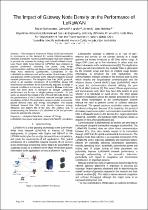JavaScript is disabled for your browser. Some features of this site may not work without it.
- ResearchSpace
- →
- Research Publications/Outputs
- →
- Conference Publications
- →
- View Item
| dc.contributor.author |
Kufakunesu, Rachel

|
|
| dc.contributor.author |
Hancke, Gerhard P

|
|
| dc.contributor.author |
Abu-Mahfouz, Adnan MI

|
|
| dc.date.accessioned | 2023-03-17T10:18:26Z | |
| dc.date.available | 2023-03-17T10:18:26Z | |
| dc.date.issued | 2022-08 | |
| dc.identifier.citation | Kufakunesu, R., Hancke, G.P. & Abu-Mahfouz, A.M. 2022. The impact of gateway node density on the performance of LoRaWAN. http://hdl.handle.net/10204/12684 . | en_ZA |
| dc.identifier.uri | http://hdl.handle.net/10204/12684 | |
| dc.description.abstract | The concept of Internet of Things (IoT) has increased in prominence as the demand for device interconnectedness increases worldwide. Numerous technologies have been proposed to provide the required technology and network infrastructure. Low Power Wide Area Networks (LPWAN) have emerged as popular preference, providing low power, long range communication, and low-cost devices, particularly in Long Range Wide Area Networks (LoRaWAN). Components of the LoRaWAN architecture such as the number of end devices (EDs) and gateways (GWs) connected to the network impact the overall network performance. The Adaptive Data Rate (ADR) protocol, which is an essential component of LoRaWAN, allows ED transmission parameters to be dynamically adjusted to adapt to network conditions to improve the network¿s lifetime. Extensive work has been done in literature to analyse LoRaWAN performance but focuses on single gateway networks. In this work, we present the impact of the GW and ED node density on the performance of the LoRaWAN network through extensive simulations in NS-3. The evaluation measures packet success rate, packet delivery ratio and energy consumption. The results obtained showed that GW node density improves energy efficiency and battery life of the EDs. The analysis aids in understanding the behaviour of LoRaWAN ADR and provides means to optimise the network. | en_US |
| dc.format | Fulltext | en_US |
| dc.language.iso | en | en_US |
| dc.relation.uri | https://www.satnac.org.za/programme | en_US |
| dc.source | The Southern Africa Telecommunication Networks and Applications Conference, Western Cape, South Africa, 28 - 30 August | en_US |
| dc.subject | Adaptive Data Rate | en_US |
| dc.subject | Internet of Things | en_US |
| dc.subject | LoRaWAN | en_US |
| dc.subject | Low-Power Wide Area Network | en_US |
| dc.subject | LPWAN | en_US |
| dc.subject | Simulation | en_US |
| dc.title | The impact of gateway node density on the performance of LoRaWAN | en_US |
| dc.type | Conference Presentation | en_US |
| dc.description.pages | 214-218 | en_US |
| dc.description.note | Paper presented at the Southern Africa Telecommunication Networks and Applications Conference, Western Cape, South Africa, 28 - 30 August 2022 | en_US |
| dc.description.cluster | Next Generation Enterprises & Institutions | en_US |
| dc.description.impactarea | EDT4IR Management | en_US |
| dc.identifier.apacitation | Kufakunesu, R., Hancke, G. P., & Abu-Mahfouz, A. M. (2022). The impact of gateway node density on the performance of LoRaWAN. http://hdl.handle.net/10204/12684 | en_ZA |
| dc.identifier.chicagocitation | Kufakunesu, Rachel, Gerhard P Hancke, and Adnan MI Abu-Mahfouz. "The impact of gateway node density on the performance of LoRaWAN." <i>The Southern Africa Telecommunication Networks and Applications Conference, Western Cape, South Africa, 28 - 30 August</i> (2022): http://hdl.handle.net/10204/12684 | en_ZA |
| dc.identifier.vancouvercitation | Kufakunesu R, Hancke GP, Abu-Mahfouz AM, The impact of gateway node density on the performance of LoRaWAN; 2022. http://hdl.handle.net/10204/12684 . | en_ZA |
| dc.identifier.ris | TY - Conference Presentation AU - Kufakunesu, Rachel AU - Hancke, Gerhard P AU - Abu-Mahfouz, Adnan MI AB - The concept of Internet of Things (IoT) has increased in prominence as the demand for device interconnectedness increases worldwide. Numerous technologies have been proposed to provide the required technology and network infrastructure. Low Power Wide Area Networks (LPWAN) have emerged as popular preference, providing low power, long range communication, and low-cost devices, particularly in Long Range Wide Area Networks (LoRaWAN). Components of the LoRaWAN architecture such as the number of end devices (EDs) and gateways (GWs) connected to the network impact the overall network performance. The Adaptive Data Rate (ADR) protocol, which is an essential component of LoRaWAN, allows ED transmission parameters to be dynamically adjusted to adapt to network conditions to improve the network¿s lifetime. Extensive work has been done in literature to analyse LoRaWAN performance but focuses on single gateway networks. In this work, we present the impact of the GW and ED node density on the performance of the LoRaWAN network through extensive simulations in NS-3. The evaluation measures packet success rate, packet delivery ratio and energy consumption. The results obtained showed that GW node density improves energy efficiency and battery life of the EDs. The analysis aids in understanding the behaviour of LoRaWAN ADR and provides means to optimise the network. DA - 2022-08 DB - ResearchSpace DP - CSIR J1 - The Southern Africa Telecommunication Networks and Applications Conference, Western Cape, South Africa, 28 - 30 August KW - Adaptive Data Rate KW - Internet of Things KW - LoRaWAN KW - Low-Power Wide Area Network KW - LPWAN KW - Simulation LK - https://researchspace.csir.co.za PY - 2022 T1 - The impact of gateway node density on the performance of LoRaWAN TI - The impact of gateway node density on the performance of LoRaWAN UR - http://hdl.handle.net/10204/12684 ER - | en_ZA |
| dc.identifier.worklist | 26555 | en_US |






